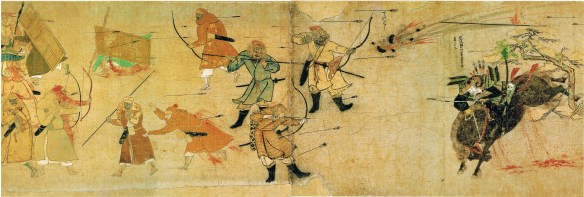The Japanese warrior Takezaki Suenaga attacks Mongol bowmen, though his horse is wounded. A bomb explodes in the air at centre.
An example of tetsuhau, the world’s oldest anti-personnel explosive, excavated from a ship wrecked during the battIe. tetsuhau is a primitive Mongol grenade. Ceramic bombs found on the 1281 shipwreck, left, prove the existence of these early explosive shells. Some historians had speculated that their depiction on scrolls recording the invasions was a later addition. (KOSUWA)
Illustration, based on contemporary depictions in scrolls and discoveries from excavation of the Takashima shipwreck, depicts a warship from the Mongol invasion fleet. (KOSUWA)
In attempted Mongol invasions of Japan.
1274 and 1281.
Date August 14–15, 1281
Location Northern Kyumshum, Japan
Opponents
[1]Japanese
[2]Mongols, with Chinese and Korean auxiliaries
Commander
[1]Unknown
[2]Kublai Khan
Approx. # Troops
[1]Unknown
[2]170,000 men and 4,500 ships
Importance Japanese stave off a Mongol invasion and maintain their independence, developing their own institutions.
Under the Kamakura shogunate 13th-century Japan was prosperous and largely peaceful, but in the second half of the century Japan came under increased pressure from the Mongols. The Mongols had come to power in China early in the 13th century as the Yuan dynasty, with the great Kublai Khan ruling China during 1260– 1294. Kublai Khan’s ambitions included not only the Eurasian landmass but the Japanese archipelago. At first he tried diplomacy, sending five diplomatic missions to the Japanese court during the period 1268–1273. The Japanese killed some of the Chinese emissaries, and Kublai Khan resolved to use force.
The first invasion, in 1274, was most probably a reconnaissance in force. Kublai Khan sent 25,000 soldiers to Korea and pressured the vassal Korean emperor to raise an army of 15,000 men and supply 900 ships to transport the men, their horses, and their equipment to Kyumshum. The Mongols first took the islands of Tsushima and Iki, between Korea and Japan, as staging areas and then landed their army at Hakata Bay (Ajkozaki) in the northwestern part of the island of Kyumshum. The Japanese hastily mobilized all available forces, but their generals had no experience in managing large bodies of troops, and the Mongols were both better armed and more effectively led. The Mongols were defeating the Japanese when a severe storm led the Mongol ship captains to call for the men to be reembarked or risk being marooned on Japanese soil. Although the majority of Mongol ships made it back to Korea, reportedly some 200 were lost at sea, and others were taken by the Japanese. The invaders suffered some 13,000 men killed in the invasion attempt.
Kublai Khan then assembled a far larger expeditionary force in two separate contingents. The Northern Fleet, which numbered as many as 70,000 Mongol and Korean soldiers in perhaps 1,000 ships, sailed from ports in northern China. The Southern Fleet was even larger. It numbered 100,000 men, to be transported in perhaps 3,500 ships. It was not yet ready when the Northern Fleet departed on May 22, 1281.
In early June the Mongols again took Tsushima and Iki as staging areas. The expeditionary force then sailed to northern Kyumshum, arriving in Hakata Bay on June 21. The Southern Fleet had not yet arrived, but the Northern Fleet troops began to go ashore on June 23. This time the Japanese were better prepared. At sea they carried out nighttime harassing attacks against the Mongol ships and destroyed some of them. While unable to defeat the Mongols on land, the Japanese were at least able to check their advance inland.
The Southern Fleet began arriving in mid-July, and its deployment was complete by August 12. The Japanese appeared lost before such a large force, but on the night of August 14–15 a violent storm (the Kamikaze, or Divine Wind) blew in from the north and wrecked most of the Mongol ships in the bay. The Japanese claimed that only about 200 of the Mongol ships survived the storm or the Japanese soldiers waiting for them when they swam ashore. Cut off from their supplies, those Mongols already ashore were easily defeated. Some 120,000 Mongols and Koreans may have perished in the invasion attempt. Reportedly the Japanese made slaves of some 12,000 others.
Outcome Disastrous as this second expedition had been, Kubilai Khan gave orders for the construction of another fleet, but a rebellion in 1286 forced him to postpone building. Kubilai’s successor Timur eventually abandoned the plan. Even though the Kamakura warriors soon afterwards plunged into domestic warfare – to last intermittently into the early 17th century – no further invasion of Japan was attempted until the 19th century. As the Yuan dynasty was replaced by the Ming dynasty in 1344, the new imperial government reverted to a less war-prone foreign policy towards its eastern neighbours. In the 14th century, friendly diplomatic relations between Japan and China prevailed and the bilateral trade grew.
References Farris, W. W. Heavenly Warriors: The Evolution of Japan’s Military, 500–1700. Cambridge: Harvard University Press, 1992. Mason, R. H. P., and J. G. Caiger. History of Japan. New York: Free Press, 1972. Turnbull, Stephen. The Samurai: A Military History. New York: Macmillan, 1977.
